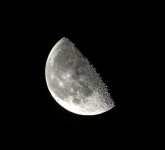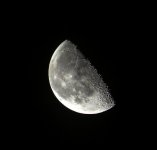- Messages
- 2,513
- Name
- Keith
- Edit My Images
- Yes
Usually when I take a moon shot I can't see the stars, and you kind people explained that's normal.
Last night when I started editing my moon shots I seemed to struggle not to see the stars ??
Furthermore, some of the stars appeared in front of the dark side of the moon, and I'm sure that's nothing to do with Pink Floyd
The stars are clearer on my original. Can anyone please explain what's going on?

Last night when I started editing my moon shots I seemed to struggle not to see the stars ??
Furthermore, some of the stars appeared in front of the dark side of the moon, and I'm sure that's nothing to do with Pink Floyd
The stars are clearer on my original. Can anyone please explain what's going on?




